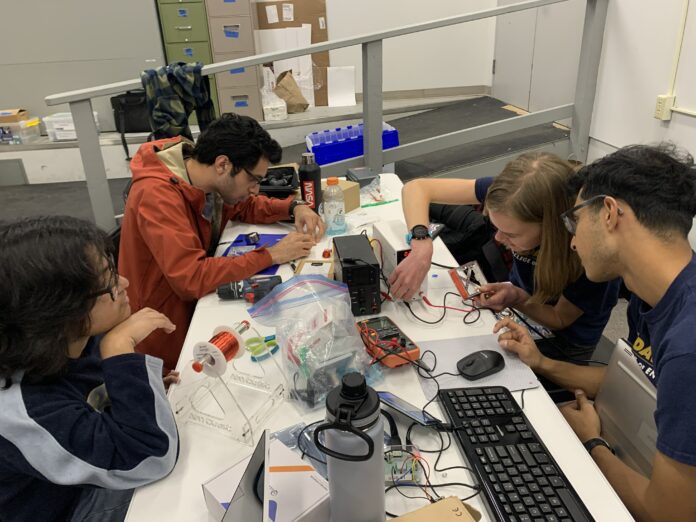UC Davis played a role in the Artemis I Mission and was chosen for NASA’s CubeSat Launch Initiative
By KAYA DO-KHANH — campus@theaggie.org
UC Davis has recently worked with NASA on two projects: the Artemis I Mission and NASA’s CubeSat Launch Initiative. These are just the most recent partnerships in a long history of collaboration with the national organization, including working on the Mars rover Curiosity in 2012 and the Mars rover Perseverance in 2018 as well as researching genetically-modified lettuce that could protect astronauts’ bones on long space flights in 2022.
The McClellan Nuclear Research Center (MNRC), which is owned and operated by UC Davis, played a part in the moon mission that was completed on Dec. 11 when the Artemis I’s Orion capsule made a splashdown after 26 days of orbiting the moon. The Orion spacecraft, which was designed for human deep space exploration, embarked on an uncrewed flight that traveled 280,000 miles from Earth and flew farther than any spacecraft for humans has ever flown, according to NASA.
The MNRC facility carries out nondestructive testing with neutron radiography. For the mission, NASA performed neutron imaging of critical equipment at the MNRC to make sure that it would operate correctly in flight.
The director of MNRC, Wesley Frey, said that the neutron imaging is done on a reactor that works similarly to X-ray radiography, but it is able to capture images of explosive material encased in metal and produce better-contrasted images. The tests image pyrotechnic devices called “frangible rings” that control the stage separation of a rocket, according to a recent press release.
“There’s about 20 to maybe two dozen small research reactors like this in the country, and not all of them are set up to do any kind of imaging,” Frey said.
The research center is one of the few centers set up to do neutron imaging for projects that require lots of images and have to meet certain quality standards. This ability makes the MNRC special, according to Frey.
“[The MNRC] was purposely built to do neutron radiography on a commercial scale, and we were really the only reactor in the United States that was ever built specifically for that purpose,” Frey said.
Frey said that the MNRC is sent equipment parts two to three years before an actual mission occurs. He explained that right now, the center is working on imaging parts for the Artemis III mission.
“It’s exciting,” Frey said. “We got a lot of the parts that we will test for the Artemis III [mission] where they’re actually planning on putting people on the surface of the moon. Most of that equipment has already come and gone.”
Once the team at MNRC images the equipment, the engineers will examine the critical pieces and give them a stamp of approval.
The MNRC isn’t the only UC Davis group that is working with NASA though. The Space and Satellite Systems (SSS) club’s student-built satellite will be going to space in 2023 as a part of NASA’s CubeSAT Launch Initiative (CSLI). The CSLI presents low-cost access to space for educational institutions and aims to “inspire […] the next generation of scientists, engineers and technologists,” according to NASA.
SSS’s satellite is the product of the work of more than 300 undergraduate students that was reviewed, scored and selected by NASA. The satellite is small and cube-shaped, according to a recent press release, and is known as the Remote Experimentation and Analysis of Low Orbit Phenomenon mission (REALOP 1).
Vice President of SSS and second-year aerospace engineering major Yuvraj Jadav said that the project started when one of the club’s members realized there could be an improvement in the spinning wheel technology currently used to orient satellites. Spinning wheels are expensive and have a difficult manufacturing process, as they require a high degree of precision and need to be balanced properly. Computer hard disk drives have almost the same characteristics as space-going reaction wheels, but are less expensive.
“Our REALOP I mission is a proof of concept satellite with the goal of using a computer hard disk drive and a manufactured reaction wheel to point itself at the Earth once in orbit and send a picture of it back down,” Jadav said via email. “We will also collect telemetry data and compare the performance of the reaction wheel against the performance of the hard disk drive. In order to get ourselves to orbit, we have partnered with NASA’s CubeSat Launch Initiative.”
Jadav said that the project has been the effort of a large group of students, explaining that there are four teams working on the project, each with five to seven subteams under them.
According to a statement by SSS co-president and fourth-year aerospace engineering major Aashay Vartak, “REALOP is the product of many people and many hours of work, and I’m really excited that we’re finally going to be able to launch it.”
Written by: Kaya Do-Khanh — campus@theaggie.org





